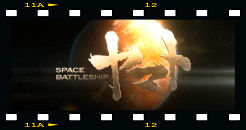 At the end of the 22nd century, planet Earth has been laid to waste by decades of radioactive planet bombs launched by the all-conquering Gamilas. The surviving human population has resorted to elaborate underground cities to survive, but the radiation will soon reach a point beyond which the surface of the Earth cannot protect them. All life on Earth is doomed.
At the end of the 22nd century, planet Earth has been laid to waste by decades of radioactive planet bombs launched by the all-conquering Gamilas. The surviving human population has resorted to elaborate underground cities to survive, but the radiation will soon reach a point beyond which the surface of the Earth cannot protect them. All life on Earth is doomed.
Captain Juzo Okita, one of the Earth Defense Force’s most seasoned leaders, commands a futile action against Gamilas forces which have now gained a solid foothold in Earth’s solar system. The battle quickly turns against the human forces, and with only two ships left of the fleet he led into battle, Okita orders a retreat. The captain of the other ship, Mamoru Kodai, disobeys direct orders and covers Okita’s retreat – at the cost of his own life. Only Okita and his surviving crew escape the slaughter, and the Gamilas presence in the solar system is left unchecked.
Susumu Kodai – Mamoru’s younger brother – ekes out a meager existence on Earth, collecting scrap metal from the radioactive surface for the war effort. Something slams into the ground near Kodai, knocking him unconscious and knocking his protective gear off. When he comes to, Kodai finds a small capsule of unknown origin – and is even more surprised that, without his protective suit intact, he hasn’t died of radiation poisoning.
Once decoded, the capsule turns out to be a message from the distant but peaceful planet Iscandar, with complete instructions for building a new propulsion system which will make the journey, as well as a powerful weapon far beyond anything presently in Earth’s arsenal.
Lodged in the surface of Earth, in an area that was once the floor of the Pacific Ocean, lies the great World War II battleship Yamato, which is secretly being refitted into an advanced, one-of-a-kind starship using Iscandar’s wave motion engine design. In a last-ditch effort to save Earth, Captain Okita assembles an all-volunteer crew to make the journey to Iscandar. The Yamato will either bring back the means to return Earth to her former glory… or it will help humanity survive by relocating the best and brightest to another world before Earth’s fiery end.
screenplay by Shimako Sato
story by Yoshinobu Nishizaki
directed by Takashi Yamazaki
music by Naoki SatoCast: Takuya Kimura (Susumu Kodai), Meisa Kuroki (Yuki Mori), Toshirô Yanagiba (Shiro Sanada), Naoto Ogata (Daisuke Shima), Hiroyuki Ikeuchi (Hajime Saito), Tsutomu Yamazaki (Juzo Okita), Shin’ichi Tsutsumi (Mamoru Kodai), Maiko (Aihara), Reiko Takashima (Doctor Sado), Toshiyuki Nishida (Hikozaemon Tokugawa), Toshihiro Yashiba (Yasuo Nanbu), Kazuki Namioka (Saburo Kato), Takumi Saitô (Akira Yamamoto), Takahiro Miura (Furuya), Kensuke Ohwada (Kenjiro Ota), Kana Harada (Sasaki), Saaya Ishikawa (Shima’s Wife), Miyû Sawai (Higashida), Natsuhi Ueno (Tobita), Megumi Shôji (Hoshino), Ryohei Aoki (Jiro Shima), Yôsuke Asari (Ando), Yumiko Fujita (Saito’s Mother), Isao Hashizume (Heikuro Todo), Masatoh Ibu (voice of Desler), Kisuke Iida (Nanba), Marika Matsumoto (Nishina), Keisuke Minami (Kazuhiko Sugiyama), Kenji Motomiya (Space Cavalier), Satoshi Nikaido (Okita’s son), Shunsuke Oe (young Susumu Kodai), Kenichi Ogata (voice of Analyzer), Kôichirô Takami (Akira Nemoto), Takeru Taniyama (young Mamoru Kodai), Miyuki Ueda (voice of Iscandar)
Review: An eagerly-awaited live-action version of the seminal ’70s anime series, Space Battleship Yamato is an interesting exercise in what’s been kept intact from the original anime vs. what’s been changed due to the realities of producing the same story in a live action movie with heavy CGI.
The basics of the story have largely been preserved: after years of unprovoked, radiation-loaded bombing by an alien race, humanity has been forced into hiding underground, facing extinction. Captain Okita, back from a disastrous mission that he escaped only thanks to the sacrifice of Captain Mamoru Kodai, sets out to recruit an all-volunteer crew for what may be a one-way mission to a planet called Iscandar, a message capsule from which has landed on Earth. Among the mostly young crew is Kodai’s younger brother, Susumu Kodai, embittered by the loss of his brother. But when he falls ill on the journey, Okita decides that the junior Kodai is the most natural leader among his crew, even though the younger man bears a grudge against him.
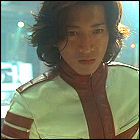 The casting of the movie is nearly perfect. Tsutomu Yamazaki is as close as you could expect a real flesh-and-blood human actor to resemble Okita, and J-pop star Takuya Kimura owns much of the movie as the hot-headed younger Kodai. The actors playing science officer Sanada and chief engineer Tokugawa are also a lot of fun to watch.
The casting of the movie is nearly perfect. Tsutomu Yamazaki is as close as you could expect a real flesh-and-blood human actor to resemble Okita, and J-pop star Takuya Kimura owns much of the movie as the hot-headed younger Kodai. The actors playing science officer Sanada and chief engineer Tokugawa are also a lot of fun to watch.
Meisa Kuroki, as Yuki Mori, is not only good at playing the role, but she’s gorgeous to look at as well. Yuki’s role in the story, however, is where the significant alterations to the story begin. The first character we see in the movie, Yuki has been promoted from a wallflower radar operator to a hotshot top-gun fighter pilot. In a similar vein, Dr. Sado is now a woman – but fear not, Dr. Sado still has a bottle and a yellow tabby cat at the ready at all times. (In other words, the character remains largely unchanged aside from gender.)
Fans of Analyzer may be shocked to learn that the robot barely makes a showing in the film – and Analyzer is not Dr. Sado’s assistant, but is instead a handheld device apparently owned by Kodai. There is an homage late in the movie to the robot Analyzer that Yamato afficionados of old will remember, but revealing any more than that would be spoiling one of the more exciting scenes. Old-school Yamato fans will take some comfort, however, in the knowledge that both Analyzer and Desler are voiced by the voice actors from the original series.
Ah yes… Desler. With a running time of about two and a half hours, and a story that’s 5/6 of the animated Yamato feature film and 1/6 Arrivederci Yamato, this Yamato simply 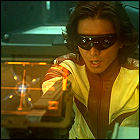 doesn’t have time to get behind enemy lines and deal with politics among the Gamilas like the original anime. Desler makes two brief appearances in this film, but in a very different form than longtime fans might expect. The same can be said of the Gamilas as a whole, given a far more alien, non-humanoid form here than we’ve ever seen before. Purists hoping for actors painted blue (though it’d hew even closer to the source material for the Gamilas to have normal human skin tones until half an hour into the movie) may be let down.
doesn’t have time to get behind enemy lines and deal with politics among the Gamilas like the original anime. Desler makes two brief appearances in this film, but in a very different form than longtime fans might expect. The same can be said of the Gamilas as a whole, given a far more alien, non-humanoid form here than we’ve ever seen before. Purists hoping for actors painted blue (though it’d hew even closer to the source material for the Gamilas to have normal human skin tones until half an hour into the movie) may be let down.
Perhaps the biggest changes to the storyline, however, involve Iscandar. The character of Stasha – not even named here – only puts in one appearance, somewhat similar to how Desler is handled, and the animation’s shock twist of Iscandar and Gamilas as warring twin planets is changed further, making Iscandar and Gamilas two hemispheres of a single doomed world at war. Stasha’s anti-radiation device is also drastically changed, including a red-herring plot complication lifted straight from the reboot of Battlestar Galactica. Furthermore, with no recurring transmissions from Iscandar, the character of Daisuke Shima is drastically reduced in importance. In the original anime, he 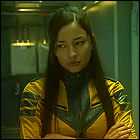 becomes Kodai’s brother-in-arms, but here he’s little more than the guy in the next seat over on the bridge. The actor playing him fits the bill, but there’s very little for him to do in a story that’s been reworked to focus with laser-like intensity on Kodai, to the exclusion of some of the other characters one would normally expect to be prominent. At the end of the movie, it’s Shima’s job to evacuate Yuki and the other survivors of the Yamato from the doomed ship, and it’s clear that a tremendous bond of respect has evolved between him and Kodai, but what led to that seems to be missing – perhaps somewhere on the cutting room floor. Also, with no Stasha to nurse him back to health, Mamoru Kodai doesn’t appear after his apparent death at the beginning of the movie. Similarly, Saito and his Marine contingent appear, but don’t have the prominence they had in animated form – there’s no jockeying for the crew’s respect with Kodai.
becomes Kodai’s brother-in-arms, but here he’s little more than the guy in the next seat over on the bridge. The actor playing him fits the bill, but there’s very little for him to do in a story that’s been reworked to focus with laser-like intensity on Kodai, to the exclusion of some of the other characters one would normally expect to be prominent. At the end of the movie, it’s Shima’s job to evacuate Yuki and the other survivors of the Yamato from the doomed ship, and it’s clear that a tremendous bond of respect has evolved between him and Kodai, but what led to that seems to be missing – perhaps somewhere on the cutting room floor. Also, with no Stasha to nurse him back to health, Mamoru Kodai doesn’t appear after his apparent death at the beginning of the movie. Similarly, Saito and his Marine contingent appear, but don’t have the prominence they had in animated form – there’s no jockeying for the crew’s respect with Kodai.
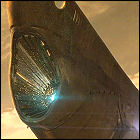 The Galactica remake also shows its influence on the movie’s visual style, as does J.J. Abrams’ 2009 Star Trek film. The CGI Yamato is a beautiful piece of work, and in several places director Takashi Yamazaki – also the movie’s VFX supervisor – sets up shots almost exactly as they appeared in the anime, such as Yamato emerging from the huge cloud of debris left behind by the first victim of the wave motion gun. (And thanks again to CGI, Yamato’s engine room is as formidable as it was in animation.) But there are also shots lifted from other things – such as Yamato warping into a planet’s atmosphere, all guns blazing, launching all fighters and then warping back into space. Someone’s clearly been watching some Galactica.
The Galactica remake also shows its influence on the movie’s visual style, as does J.J. Abrams’ 2009 Star Trek film. The CGI Yamato is a beautiful piece of work, and in several places director Takashi Yamazaki – also the movie’s VFX supervisor – sets up shots almost exactly as they appeared in the anime, such as Yamato emerging from the huge cloud of debris left behind by the first victim of the wave motion gun. (And thanks again to CGI, Yamato’s engine room is as formidable as it was in animation.) But there are also shots lifted from other things – such as Yamato warping into a planet’s atmosphere, all guns blazing, launching all fighters and then warping back into space. Someone’s clearly been watching some Galactica.
Another shot lifted directly from the animation is the appearance of the ghosts of the deceased crew members urging Kodai on as Yamato’s final attack is launched. This echoes a shot from Arrivederci Yamato almost exactly, though those not familiar with the source material (or the age of the source material) might well think it’s an homage to Return Of The Jedi.

If there’s one major problem with Yamato, it is that one of the things it borrows from animated predecessor Arrivederci Yamato is its fatalistic ending. I’d predict that this movie, by using that ending, will be a one-off… but then again, that never stopped the animated Yamato franchise, which later redacted that kill-off-almost-everybody conclusion. But if there was a franchise waiting to happen – and after seeing the movie, one can’t help but marvel at the possibility of more Yamato adventures like this one – you’d think the makers of this film would’ve learned from the makers of the previous Yamato adventures. (On the other hand, if all that a live-action franchise would accomplish would be to retell the anime stories ad nauseum, maybe it’s a mercy killing.)
But that’d be such a shame with all the loving detail that went into this movie. The uniforms, which were inventive for animation, could’ve wound up looking goofy as costumes worn by real actors, and yet a great deal of thought went into reworking them into jackets with the same lines – right down to the divisional colors and the giant arrow/anchor pointing down – as practical garments. The Yamato sets are functional, and a nice combination of familiar spaces and shapes filled out with new details (the Yamato bridge, the heart of much of the movie, is a great example of this). The production design takes things like costumes and sets from the anime and turns them into practical, real-world designs without losing a thing. Surely, for all of that effort, we could’ve gotten more than a single story out of this cast and crew.
